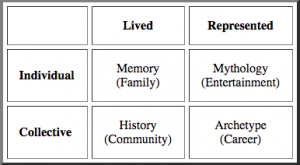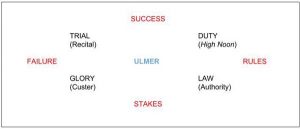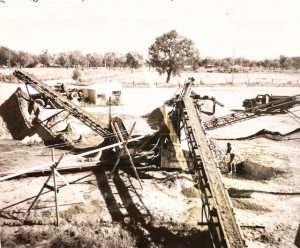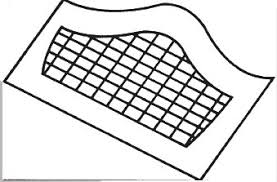Wide Image: Mythology

 Structuralism: Claude Lévi-Strauss. Following the rule of heuretics curriculum, to treat one’s own materials as belonging to the disciplinary tradition, I applied Lévi-Strauss’s insights into the formal design of mythologies to my wide image. The wide mage in fact is a personal mythology, not only metaphorically but formally. Lévi-Strauss showed that individual instances of a myth manifest a system of relationships, covering all possible variations on the aporia (disaster in our terms) addressed by the myth. The system of relationships is that of proportional analogy (A is to B as C is to D), the figure of hypotyposis encountered throughout the tradition. The practice of myth-work applied to a mystory set (including the Career register documented, along with Family, Entertainment, Community) is to determine which stories/scenes are related in this proportional ratio, along what axes? In my case I found Family and Career related on an axis of space (The Sand and Gravel Plant scene, materializing the Choral metaphor of Plato and Derrida); Entertainment and History related on an axis of time. High Noon plays out almost in real time, intercutting between the clock in the sheriff’s office and the gunmen waiting for their boss to arrive on the noon train, while the sheriff tries to form a posse to fight them. Custer took his Seventh Cavalry far ahead of the rest of the advancing army, hoping to strike a quick blow against the Indians, to get the glory for himself, to propel him into candidacy for President of the United States in the 1876 election.. The symmetries formed in the crossings of this four-fold are provocative, suggestive of a diagram capable of translation into an original hypothesis for konsult.
Structuralism: Claude Lévi-Strauss. Following the rule of heuretics curriculum, to treat one’s own materials as belonging to the disciplinary tradition, I applied Lévi-Strauss’s insights into the formal design of mythologies to my wide image. The wide mage in fact is a personal mythology, not only metaphorically but formally. Lévi-Strauss showed that individual instances of a myth manifest a system of relationships, covering all possible variations on the aporia (disaster in our terms) addressed by the myth. The system of relationships is that of proportional analogy (A is to B as C is to D), the figure of hypotyposis encountered throughout the tradition. The practice of myth-work applied to a mystory set (including the Career register documented, along with Family, Entertainment, Community) is to determine which stories/scenes are related in this proportional ratio, along what axes? In my case I found Family and Career related on an axis of space (The Sand and Gravel Plant scene, materializing the Choral metaphor of Plato and Derrida); Entertainment and History related on an axis of time. High Noon plays out almost in real time, intercutting between the clock in the sheriff’s office and the gunmen waiting for their boss to arrive on the noon train, while the sheriff tries to form a posse to fight them. Custer took his Seventh Cavalry far ahead of the rest of the advancing army, hoping to strike a quick blow against the Indians, to get the glory for himself, to propel him into candidacy for President of the United States in the 1876 election.. The symmetries formed in the crossings of this four-fold are provocative, suggestive of a diagram capable of translation into an original hypothesis for konsult.
–Noon Star Diagram


 Wide Image into Diagram. The next step after using the emblem catechism to generate wide image is to begin translation into diagrams, extracting patterns from the intervals and relationships emerging within the matrix. Composing my first mystory in the mid-1980s, “Derrida at the Little Bighorn,” I discovered a match between Family and Career that produced an epiphany I have developed ever since. One of my first jobs when I worked at the plant was to clean the grids of the screens used to grade the gravel into sizes. Eventually the screens plugged up with stones and I had to knock them loose with a hammer. The pea-gravel screen could be cleaned by running the tip of a large screwdriver along the meshed grids, which produced an almost musical sound. This was the actual “gravel plant.” The washer with its three grades of screen, one on top of the other, was fed by a conveyor belt carrying the pit gravel from the quarry, and fed in turn three piles of sized rock, with the sand coming out the bottom. The whole contraption made a terrible noise and shook violently. I realized years later, reading Plato’s Timaeus after Derrida, that this gravel washer was a good metaphor or model for the operation of chora, sorting chaos into Earth, Air, Fire, Water.
Wide Image into Diagram. The next step after using the emblem catechism to generate wide image is to begin translation into diagrams, extracting patterns from the intervals and relationships emerging within the matrix. Composing my first mystory in the mid-1980s, “Derrida at the Little Bighorn,” I discovered a match between Family and Career that produced an epiphany I have developed ever since. One of my first jobs when I worked at the plant was to clean the grids of the screens used to grade the gravel into sizes. Eventually the screens plugged up with stones and I had to knock them loose with a hammer. The pea-gravel screen could be cleaned by running the tip of a large screwdriver along the meshed grids, which produced an almost musical sound. This was the actual “gravel plant.” The washer with its three grades of screen, one on top of the other, was fed by a conveyor belt carrying the pit gravel from the quarry, and fed in turn three piles of sized rock, with the sand coming out the bottom. The whole contraption made a terrible noise and shook violently. I realized years later, reading Plato’s Timaeus after Derrida, that this gravel washer was a good metaphor or model for the operation of chora, sorting chaos into Earth, Air, Fire, Water. –Derrida, Chora-L As part of his collaboration with the architect, Peter Eisenman, on a design for one of the folies, to be included in the Park for Creativity, Parc de la Villette, in Paris, Derrida produced a drawing and a descriptive concept for an impossible project: to build Chora. “I propose therefore the following ‘materialisation’: in one or three exemplars (with different scalings) a gilded metallic object will be planted obliquely in the ground. Neither vertical nor horizontal, a most solid frame will resemble at once a mesh, sieve, or grid and a stringed musical instrument. An interpretive and selective filter which will have permitted a reading and sifting of the three sites [at the Park] and the three embeddings.”
–Derrida, Chora-L As part of his collaboration with the architect, Peter Eisenman, on a design for one of the folies, to be included in the Park for Creativity, Parc de la Villette, in Paris, Derrida produced a drawing and a descriptive concept for an impossible project: to build Chora. “I propose therefore the following ‘materialisation’: in one or three exemplars (with different scalings) a gilded metallic object will be planted obliquely in the ground. Neither vertical nor horizontal, a most solid frame will resemble at once a mesh, sieve, or grid and a stringed musical instrument. An interpretive and selective filter which will have permitted a reading and sifting of the three sites [at the Park] and the three embeddings.”